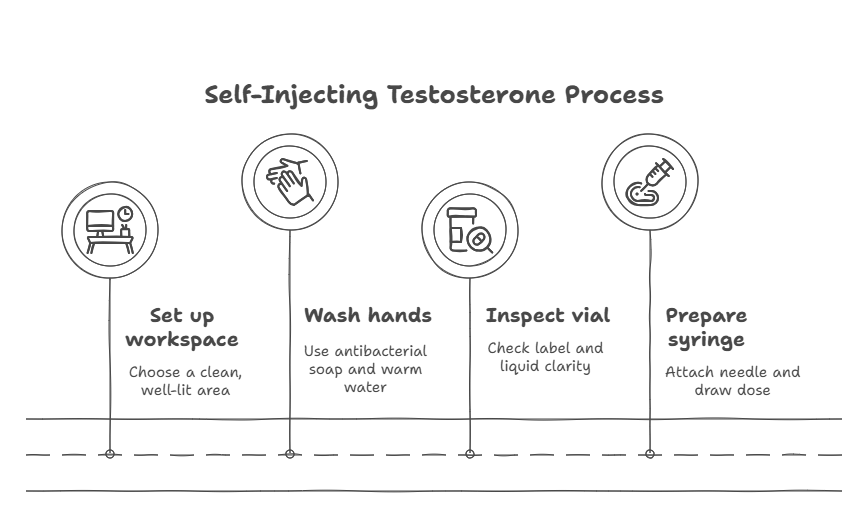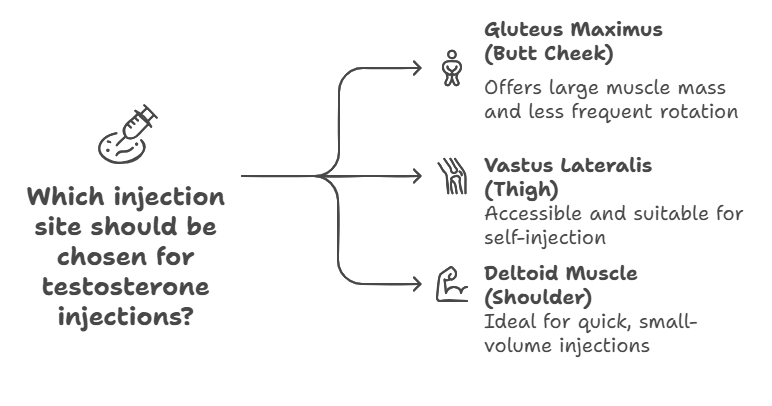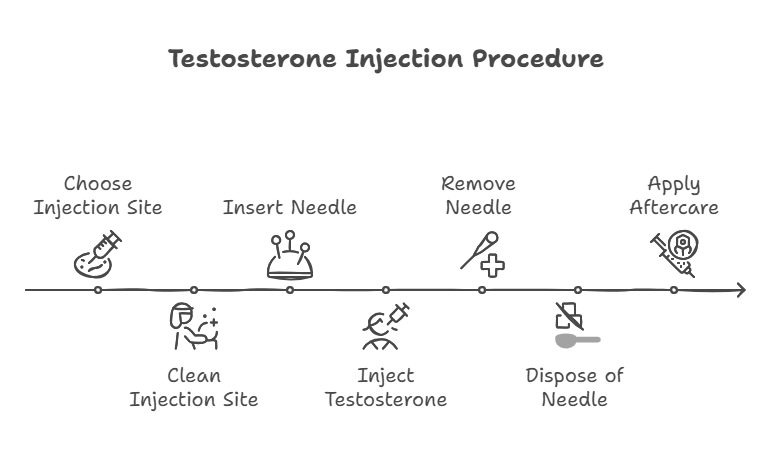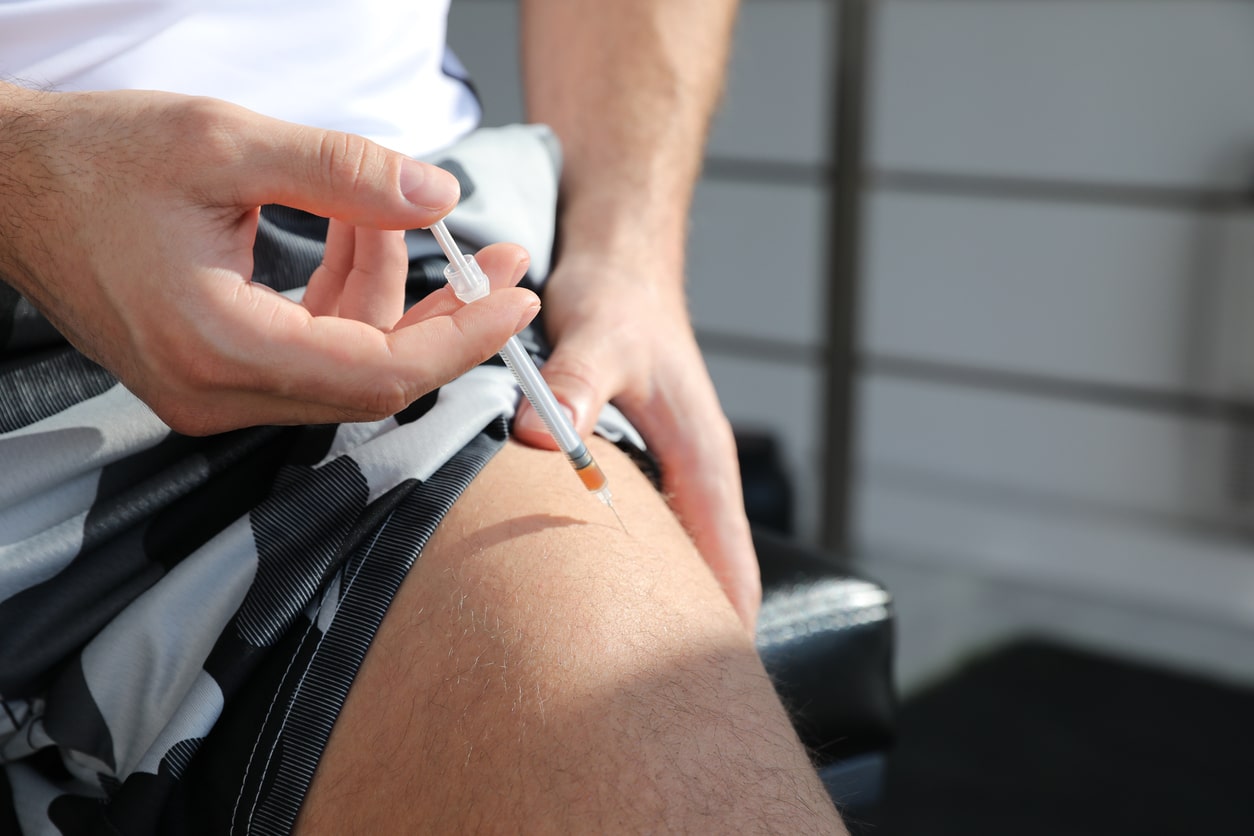Self-injecting testosterone can generally be a safe and effective way to manage hormone therapy when done correctly with prescribed testosterone.
While the process may initially seem intimidating, following a detailed step-by-step approach ensures safety, reduces discomfort, and builds confidence over time. With practice and the proper preparation, self-injections can become a quick and simple part of your routine. It is crucial to avoid common mistakes during the self-injection process by following proper procedures and physician instructions.
Materials Checklist
Before beginning, gather the following materials:
- Testosterone vial (prescribed by your healthcare provider).
- Syringe (consult your provider for the appropriate size).
- Needle for drawing (18–20 gauge) and injecting (22–25 gauge).
- Antibacterial soap.
- Alcohol swabs.
- Sharps container for safe needle disposal.
- Band-Aid.
Preparation Steps

- Set up your workspace:
- Choose a clean, well-lit area free of distractions.
- Lay out all necessary materials on a sanitized surface.
- Wash your hands thoroughly:
- Use antibacterial soap and warm water, scrubbing for at least 20 seconds.
- Inspect the testosterone vial:
- Check the label to confirm it’s the correct medication and dosage.
- Ensure the liquid is clear and free of particles or discoloration.
- Prepare the syringe and medication:
- Attach the drawing needle (18–20 gauge) to the syringe.
- Swab the vial’s rubber stopper with an alcohol swab.
- Insert the needle into the vial and draw the prescribed dose slowly to avoid air bubbles.
- Tap the syringe gently to release trapped air, then push the plunger to remove excess air.
Choosing an Injection Site for Testosterone Injections
Choosing the right injection site is crucial for safe and effective testosterone injections. The most common injection sites for testosterone injections are the gluteus maximus (buttocks), vastus lateralis (thigh), and deltoid muscle (shoulder).

When selecting an injection site, it’s essential to consider factors such as muscle tissue, blood vessel location, and personal comfort. To minimize the risk of complications, it’s recommended to rotate injection sites and avoid injecting into the same area repeatedly. Always use a sterile alcohol pad to clean the injection site and a sterile cotton swab to apply pressure after the injection.
Testosterone Injection Technique

- Choose an injection site:
- Thigh (vastus lateralis): Easy to access and ideal for beginners.
- Glute (upper outer quadrant): Preferred for larger muscle absorption. The left glute and right glute are common sites, with the top left corner of the left glute being an ideal injection point.
- Deltoid (upper arm): Suitable for smaller doses.
- Rotate injection sites to avoid irritation or scar tissue.
When choosing between intramuscular injections and subcutaneous injections, note that intramuscular injections allow for larger volumes of medication to be delivered directly into the muscle, while subcutaneous injections involve delivering medication into the fatty tissue, which is generally less painful and easier to self-administer.
- Clean the injection site:
- Swab the area with an alcohol pad, moving outward in a circular motion. Let it air dry.
- Insert the needle:
- Switch to the injection needle (22–25 gauge).
- Hold the syringe like a dart and insert the needle at a 90-degree angle for the glute or thigh, or at a 45-degree angle for smaller muscles.
- Inject the testosterone:
- Pull back the plunger slightly to check for blood (if blood enters, withdraw the needle and try a new site).
- Push the plunger slowly and steadily to inject the medication.
- Remove the needle and dispose of it safely:
- Pull the needle out at the same angle it was inserted.
- Immediately place the used needle in a sharps container.
Aftercare Instructions
- Apply gentle pressure to the injection site with a clean cotton swab or tissue.
- Use a Band-Aid if there’s minor bleeding.
- Massage the area gently to help disperse the medication and reduce soreness.
- Monitor the site for redness, swelling, or discomfort.
Safety and Troubleshooting: Common Mistakes
- Avoid contamination: Never reuse needles or syringes; always clean your hands and materials before starting.
- Minimize discomfort: Use a new needle for each injection and ensure the medication is at room temperature.
- When to seek help: Contact your healthcare provider if you notice signs of infection (redness, warmth, pus) or if you experience unusual pain or swelling.
- Common mistakes: Avoid improper needle insertion, incorrect dosage, and not following physician instructions. These errors can compromise the safety and effectiveness of the injections. Always seek professional guidance for proper procedures when in doubt.
That’s It!
Congratulations, you did it. Remember, practice makes perfect. With each injection, you’ll gain confidence and skill.
If you have concerns or need additional guidance, call us!
Temecula, CA: (951) 540-0020
Bellevue, WA: (425) 233-8623





